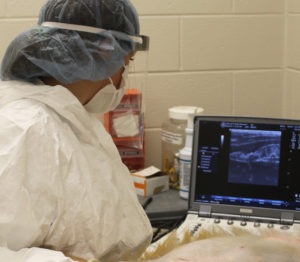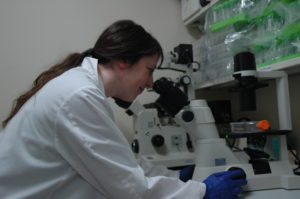This is an accordion element with a series of buttons that open and close related content panels.
How does prenatal Zika virus infection affect pregnancy and neonatal well-being?
 Working with a macaque model of in utero Zika virus infection, we define the spectrum of sensory deficits (hearing, vision) and specific brain abnormalities that affect prenatally exposed infants. Using quantitative brain imaging and visual electrophysiology studies, we can better define the specific neural pathways affected by Zika virus exposure. We are also defining the role that chronic immunosuppression, in the form of simian immunodeficiency virus infection, has on prenatal Zika virus infection. These projects are the epitome of Team Science (the Zika Experimental Science Team = ZEST), with contributions from human clinicians, basic scientists, and veterinary specialists. We collaborate with Dr. David O’Connor and Dr. Thaddeus Golos in these studies.
Working with a macaque model of in utero Zika virus infection, we define the spectrum of sensory deficits (hearing, vision) and specific brain abnormalities that affect prenatally exposed infants. Using quantitative brain imaging and visual electrophysiology studies, we can better define the specific neural pathways affected by Zika virus exposure. We are also defining the role that chronic immunosuppression, in the form of simian immunodeficiency virus infection, has on prenatal Zika virus infection. These projects are the epitome of Team Science (the Zika Experimental Science Team = ZEST), with contributions from human clinicians, basic scientists, and veterinary specialists. We collaborate with Dr. David O’Connor and Dr. Thaddeus Golos in these studies.
How does Zika virus pass from the mother to the fetus?
 Using a macaque model of Zika virus infection during pregnancy, we are defining the route the Zika virus takes shortly after infection on its way to the fetal compartment. Dr. Thaddeus Golos is our collaborator on this project.
Using a macaque model of Zika virus infection during pregnancy, we are defining the route the Zika virus takes shortly after infection on its way to the fetal compartment. Dr. Thaddeus Golos is our collaborator on this project.
What are the early predictors of developmental deficits in macaque infants exposed to Zika virus in utero? What is the underlying neuropathogenesis of these deficits?

Pregnant women with Zika virus infection can transmit the virus to their unborn children, which results in multiple birth defects including brain abnormalities, visual abnormalities, and hearing loss. It is critical to define disease pathogenesis and early predictors of neurodevelopmental deficits in a controlled setting. We are characterizing sensory and motor neurodevelopment in infant macaques and correlating these outcomes with quantitative markers of visual function, hearing and brain structure in order to identify early predictors of neurodevelopmental deficits that can be used to design future human clinical studies. We collaborate with Dr. Karla Ausderau on these projects. We will define the specific brain abnormalities associated with deficits using quantitative neuroanatomy approaches with our collaborator, Dr. Kevin Noguchi.
How does Mpox (formerly Monkeypox) virus pass from the mother to the fetus and how does prenatal Mpox virus infection affect pregnancy and neonatal well-being?
Little is known about the impact of MPXV infection on pregnant people or developing fetuses. We will determine the rate and pathways of vertical transmission, define the association of mpox disease severity and adverse pregnancy outcomes, and determine whether antiviral treatment can improve pregnancy outcomes in a translational macaque model. This will fill critical knowledge gaps in the clinical care of pregnant persons that cannot be learned from epidemiological studies alone











